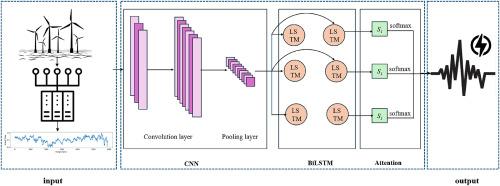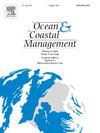基于深度学习的海上风电发电混合注意机制与双向长短期记忆预测研究
IF 5.4
2区 环境科学与生态学
Q1 OCEANOGRAPHY
引用次数: 0
摘要
海上风能在全球向可再生能源转型中发挥着关键作用,为可持续和大规模发电提供了巨大潜力。风电的准确预测对于有效的电网整合、资源优化和运营规划至关重要。本研究引入了一种新的混合模型CNN-BiLSTM-Attention,专门用于提高海上风电预测的精度。该模型协同结合了卷积神经网络(CNN)用于捕获空间和局部特征,双向长短期记忆(BiLSTM)网络用于建模双向时间依赖性,以及带有动态偏移项(δt)的增强注意机制,该机制动态调整注意权重,以实现实时和特定任务的特征优先级。该模型利用东海福建省某海上风电场5920组高分辨率观测数据进行训练和测试,该风电场额定装机容量为280兆瓦。与基准模型(包括LSTM、BiLSTM、CNN-LSTM和CNN-BiLSTM)的对比分析表明,与CNN-BiLSTM最佳基准相比,该模型的RMSE降低了13.53%,R2提高了8.00%,MAE降低了23.97%,MAPE降低了28.66%。该模型捕获了复杂海上条件下的短期波动和长期趋势,包括风波动、温度梯度、大气压变化,增强了多时间尺度的预测适应性。这些发现强调了将先进的深度学习技术与增强的注意力机制相结合用于海上风电预测的鲁棒性和准确性,为促进可再生能源整合和可持续电网管理提供了强大的工具。本文章由计算机程序翻译,如有差异,请以英文原文为准。

Investigation on forecast of offshore wind power generation hybrid attention mechanism and bi-directional long short-term memory based on deep learning
Offshore wind energy plays a pivotal role in the global transition to renewable energy, offering vast potential for sustainable and large-scale power generation. Accurate forecasting of wind power is critical for efficient grid integration, resource optimization, and operational planning. This study introduces a novel hybrid model, CNN-BiLSTM-Attention, specifically designed to improve the precision of offshore wind power forecasting. The model synergistically combines convolutional neural networks (CNN) for capturing spatial and local features, bidirectional long short-term memory (BiLSTM) networks for modeling bidirectional temporal dependencies, and an enhanced Attention mechanism with a dynamic offset term (δt), which dynamically adjusts attention weights to enable real-time and task-specific feature prioritization. The model is trained and tested using 5920 sets of high-resolution observational data collected from an offshore wind farm located in Fujian Province in the East China Sea, with a rated installed capacity of 280 MW. Comparative analyses against baseline models—including LSTM, BiLSTM, CNN-LSTM, and CNN-BiLSTM—demonstrate that the proposed model reduces RMSE by 13.53 %, increases R2 by 8.00 %, lowers MAE by 23.97 %, and decreases MAPE by 28.66 % compared to the CNN-BiLSTM best-performing baseline. The model captures both short-term fluctuations and long-term trends under complex offshore conditions, including wind fluctuations, temperature gradients, atmospheric pressure variability, enhancing forecasting adaptability across multiple time scales. These findings underscore the robustness and accuracy of combining advanced deep learning techniques with enhanced Attention mechanisms for offshore wind power forecasting, providing a powerful tool for facilitating renewable energy integration and sustainable grid management.
求助全文
通过发布文献求助,成功后即可免费获取论文全文。
去求助
来源期刊

Ocean & Coastal Management
环境科学-海洋学
CiteScore
8.50
自引率
15.20%
发文量
321
审稿时长
60 days
期刊介绍:
Ocean & Coastal Management is the leading international journal dedicated to the study of all aspects of ocean and coastal management from the global to local levels.
We publish rigorously peer-reviewed manuscripts from all disciplines, and inter-/trans-disciplinary and co-designed research, but all submissions must make clear the relevance to management and/or governance issues relevant to the sustainable development and conservation of oceans and coasts.
Comparative studies (from sub-national to trans-national cases, and other management / policy arenas) are encouraged, as are studies that critically assess current management practices and governance approaches. Submissions involving robust analysis, development of theory, and improvement of management practice are especially welcome.
 求助内容:
求助内容: 应助结果提醒方式:
应助结果提醒方式:


